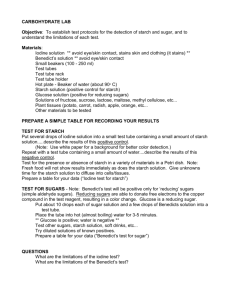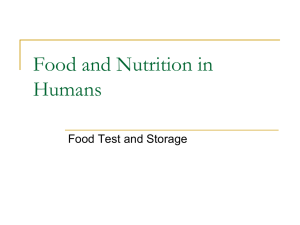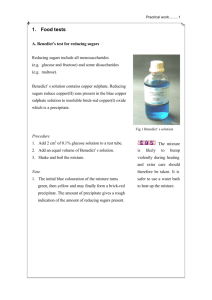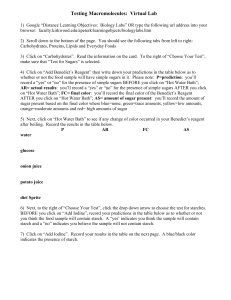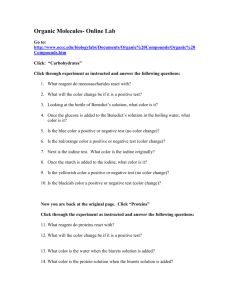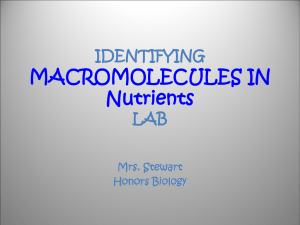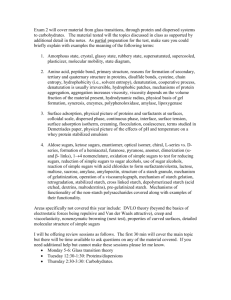Testing for reducing and non-reducing sugars teacher notes
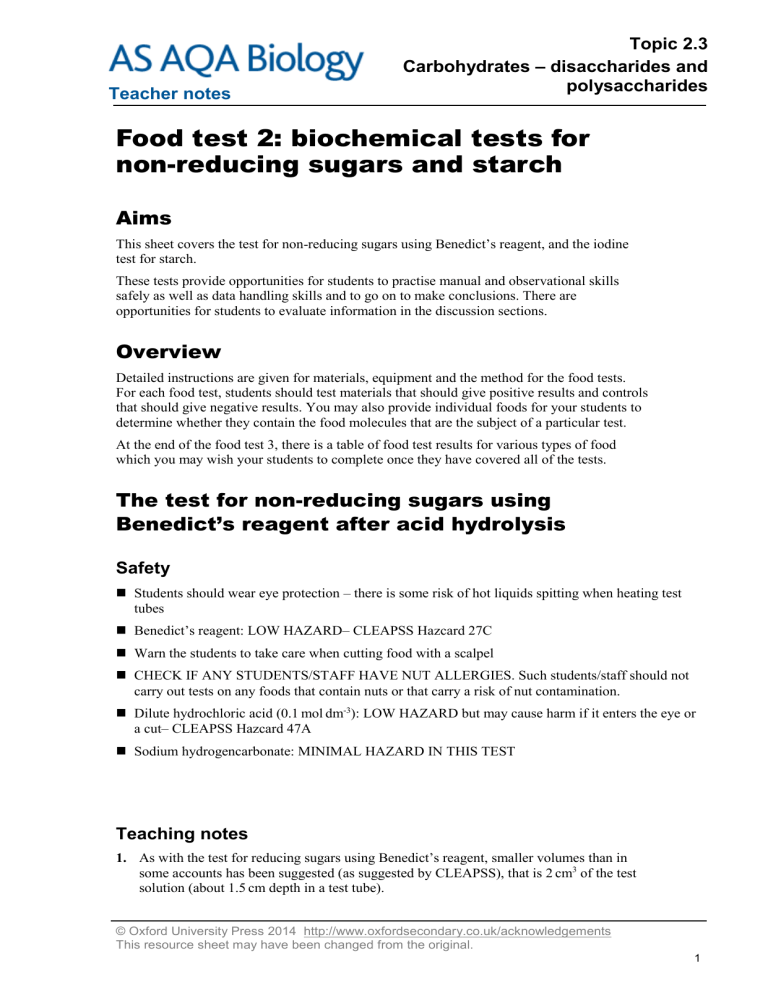
Teacher notes
Topic 2.3
Carbohydrates – disaccharides and polysaccharides
Food test 2: biochemical tests for non-reducing sugars and starch
Aims
This sheet covers the test for non-reducing sugars using Benedict’s reagent, and the iodine test for starch.
These tests provide opportunities for students to practise manual and observational skills safely as well as data handling skills and to go on to make conclusions. There are opportunities for students to evaluate information in the discussion sections.
Overview
Detailed instructions are given for materials, equipment and the method for the food tests.
For each food test, students should test materials that should give positive results and controls that should give negative results. You may also provide individual foods for your students to determine whether they contain the food molecules that are the subject of a particular test.
At the end of the food test 3, there is a table of food test results for various types of food which you may wish your students to complete once they have covered all of the tests.
The test for non-reducing sugars using
Benedict’s reagent after acid hydrolysis
Safety
Students should wear eye protection – there is some risk of hot liquids spitting when heating test tubes
Benedict’s reagent: LOW HAZARD– CLEAPSS Hazcard 27C
Warn the students to take care when cutting food with a scalpel
CHECK IF ANY STUDENTS/STAFF HAVE NUT ALLERGIES. Such students/staff should not carry out tests on any foods that contain nuts or that carry a risk of nut contamination.
Dilute hydrochloric acid (0.1
mol dm -3 ): LOW HAZARD but may cause harm if it enters the eye or a cut– CLEAPSS Hazcard 47A
Sodium hydrogencarbonate: MINIMAL HAZARD IN THIS TEST
Teaching notes
1.
As with the test for reducing sugars using Benedict’s reagent, smaller volumes than in some accounts has been suggested (as suggested by CLEAPSS), that is 2 cm 3 of the test solution (about 1.5
cm depth in a test tube).
© Oxford University Press 2014 http://www.oxfordsecondary.co.uk/acknowledgements
This resource sheet may have been changed from the original.
1
Teacher notes
Topic 2.3
Carbohydrates – disaccharides and polysaccharides
2.
Boiling a 1% sucrose solution for two minutes with 10 drops of dilute hydrochloric acid is plenty of time for the hydrolysis of sucrose. (In a test, 30 seconds was enough and the temperature of the acidified test solution did not go above 70 ºC.)
3.
Adding sodium hydrogencarbonate powder to the cooled test solution until the fizzing/effervescence stops usually signifies that the test solution is alkaline. But the use of universal indicator paper to check the pH is useful reinforcement.
4.
Ten drops of Benedict’s reagent and two minutes of heating are sufficient to give a positive result at this stage, showing the initial solution contains a non-reducing sugar
(most probably sucrose). The development of the brick-red precipitate at this stage seems to take longer than with, for example, a 1% glucose solution or even a 0.1% glucose solution.
5.
As mentioned with the test for reducing sugars, keeping the heating to close to the minimum values helps to reduce the rate of increase of CO
2
and CO levels in the lab.
Discussion
1.
A student did not read the practical schedule carefully enough and found a brick-red suspension for the test for reducing sugars and the test for non-reducing sugars. (a) What can be concluded from these results? ( b) What cannot be concluded from these results? a) The test solution contained reducing sugars. b) The test solution contained non-reducing sugars (and that the test solution did not contain non-reducing sugars).
2.
Trehalose is also a non-reducing sugar formed from two glucose units that are joined by a
1-1 alpha glycosidic bond (unlike the 1-4 alpha glycosidic bond between the two glucose units of the reducing disaccharide, maltose). The glycosidic bond of trehalose is very difficult to hydrolyse.
Suggest why trehalose might not give a positive result in the test for non-reducing sugars using Benedict’s reagent.
The test depends on the non-reducing disaccharide being hydrolysed by boiling in an acidic solution to form monosaccharides that are reducing sugars. This does not happen with trehalose.
The iodine test for starch
Safety
Iodine solution: NOT HAZARDOUS – CLEAPSS Hazcard 54B. Avoid getting iodine solution on skin or clothes
Warn the students to take care when cutting food with a scalpel
CHECK IF ANY STUDENTS/STAFF HAVE NUT ALLERGIES. Such students/staff should not carry out tests on any foods that contain nuts or that carry a risk of nut contamination.
© Oxford University Press 2014 http://www.oxfordsecondary.co.uk/acknowledgements
This resource sheet may have been changed from the original.
2
Teacher notes
Topic 2.3
Carbohydrates – disaccharides and polysaccharides
Teaching notes
The iodine test for starch can be carried out using a dimple tile or test tubes. For most solid materials that are made of cells, just cutting the material to expose the inside of the cells allows the iodine solution to gain access to any starch. To show starch in green leaves requires extra steps, that is, boil the leaf in water, decolourise in water-bath warmed industrial methylated spirits (IMS) in a boiling tube, soften in water, then add iodine solution to the leaf in a Petri dish.
Discussion
1.
Which of the materials you tested (a) contained starch and (b) did not contain starch? a) Starch suspension (and potatoes, etc.) b) Distilled water (and onions, etc.)
2.
How could you show that a yellow liquid contains iodine?
By adding a (1%) starch suspension to it: the iodine-containing liquid will turn blue-black.
Heating and cooling the starch/iodine mixture: an extension
Starch contains both amylose and amylopectin molecules. The coils of its amylose molecules take up iodine molecules from iodine solution and form the blue-black, starch–iodine
(polyiodide) complex.
If a starch–iodine complex is heated in a test tube (over a water bath), the blue-black colour is gradually lost. The heat increases the vibration within the amylose molecules of starch so that the hydrogen bonds that maintain its coils of amylose are broken, allowing the iodine molecules to leave and the yellow colour of iodine to be seen again.
When the suspension is cooled, the blue-black colour slowly reforms. Hence the iodine test for starch involves a physical change.
© Oxford University Press 2014 http://www.oxfordsecondary.co.uk/acknowledgements
This resource sheet may have been changed from the original.
3

